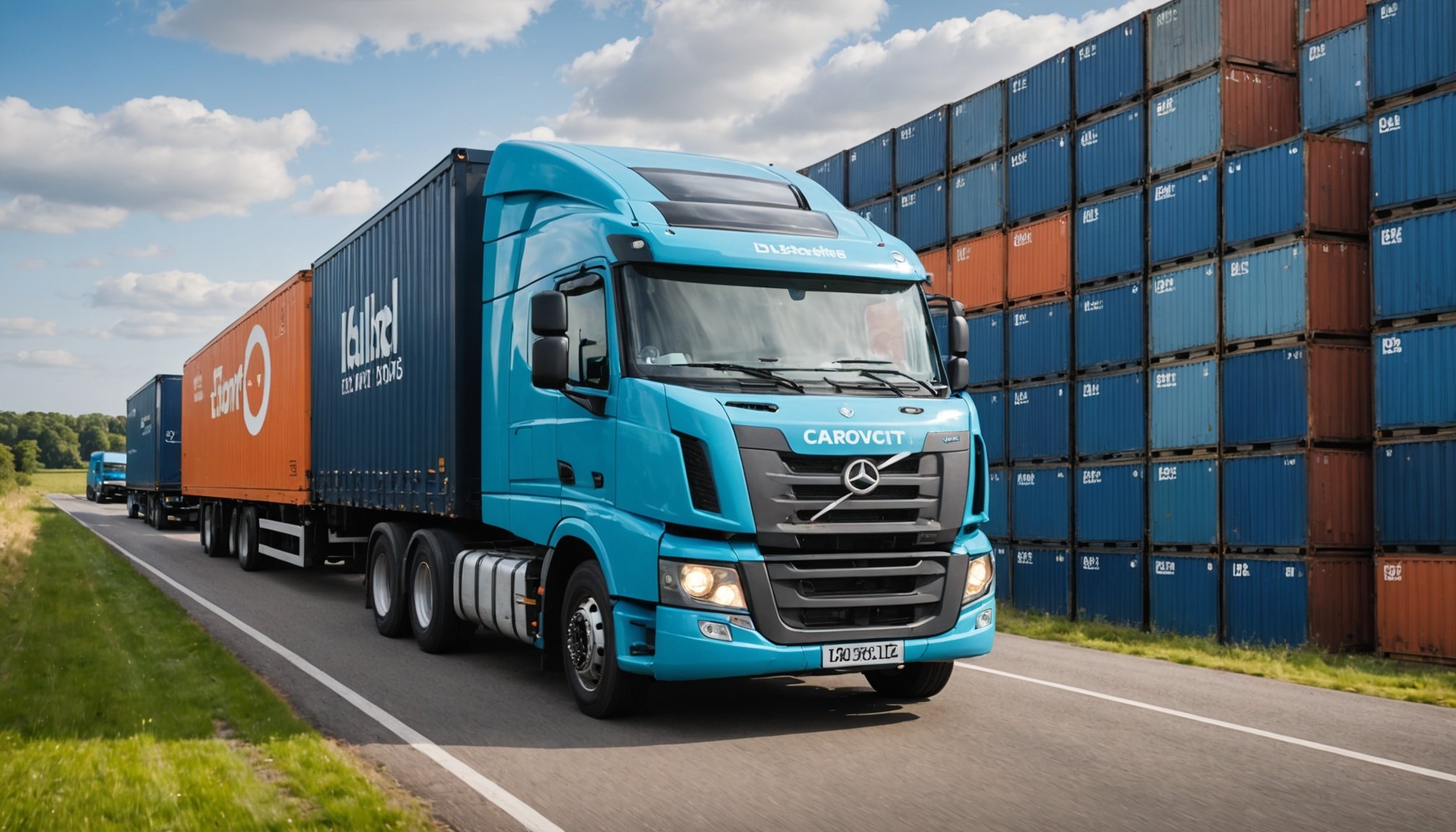Top Strategies for Lowering Carbon Footprint in UK Logistics: A Comprehensive Guide
In the face of climate change, reducing carbon footprint has become a critical priority for businesses across all sectors, including logistics. The UK, with its ambitious targets to achieve a 78% reduction in emissions by 2035 compared to 1990 levels, is at the forefront of this effort. Here’s a detailed guide on the top strategies for lowering the carbon footprint in UK logistics, helping your business contribute to a more sustainable future.
Understanding Your Carbon Footprint
Before diving into strategies, it’s essential to understand the scope of your carbon footprint. In logistics, emissions are categorized into three scopes:
In the same genre : Unlocking Success: Innovative Strategies for UK Businesses to Harness Open Innovation
Scope 1 Emissions
These are direct emissions from sources owned or controlled by your business, such as fuel combustion from vehicles and equipment.
Scope 2 Emissions
These are indirect emissions from the generation of purchased electricity, heat, or steam.
Also to discover : Unlocking Supply Chain Transparency: A Guide for UK Businesses to Harness Blockchain Technology
Scope 3 Emissions
These are indirect emissions that occur in your value chain, including business travel, employee commuting, and emissions from purchased goods and services. According to the CDP, Scope 3 emissions often account for more than 70% of a business’s carbon footprint[1].
Setting Realistic Emission Targets
Setting achievable yet ambitious emission reduction targets is crucial. Here are some steps to follow:
Align with National Targets
The UK aims for a 78% reduction in emissions by 2035. For UK SMEs, typical reduction targets range from a 30-50% reduction over 5-10 years[1].
Use Science-Based Targets
Ensure your goals are in line with climate science by applying the concept of Science-Based Targets. This approach helps in setting targets that are consistent with the level of decarbonization required to meet the goals of the Paris Agreement.
Example: Anglian Water
Anglian Water, the largest water and recycling company in England and Wales, has set a target to achieve Net Zero by 2030. They have reduced capital carbon by 63% since 2010 by embedding carbon considerations into the design and delivery of major projects[3].
Creating an Action Plan for Implementation
A practical action plan is essential for implementing your carbon reduction strategies. Here’s how you can structure it:
Assign Responsibilities and Set Timelines
Use a spreadsheet or template to assign responsibilities, set timelines, and allocate resources. Include columns for project description, expected carbon savings, cost, timeline, and the responsible person[1].
Monitor and Report Progress
Regular data collection and analysis are crucial to track progress against targets. Choose appropriate key performance indicators (KPIs) and report on these internally and externally. Businesses that actively monitor and manage their carbon emissions can achieve annual energy cost savings of 5-10%[1].
Energy Efficiency and Green Technologies
Energy efficiency and the adoption of green technologies are among the most effective strategies for reducing carbon footprint.
Energy Efficiency Measures
Start with simple behavioural changes like encouraging staff to switch off equipment when not in use. Technological solutions such as installing smart meters or energy management systems can also significantly reduce energy costs. According to the Carbon Trust, SMEs can reduce energy costs by up to 25% through energy efficiency measures[1].
Green IT Practices
Digital technologies and green IT practices can play a significant role. Energy-efficient computing practices, cloud computing, and digital tools for optimizing business processes can all contribute to reduced resource use and emissions. The UK’s digital technology sector has the potential to enable a 24% reduction in UK carbon emissions by 2030[1].
Promoting Sustainable Business Travel and Commuting
Business travel and employee commuting are significant contributors to your organisation’s carbon footprint.
Reduce Business Travel
Strategies include reducing business travel through video conferencing, promoting public transport use, and transitioning to electric or hybrid vehicles for company fleets. Cycle-to-work schemes can also encourage employees to choose low-carbon commuting options[1].
Example: Encouraging Sustainable Commuting
Encourage employees to opt for sustainable commuting methods such as cycling, walking, or carpooling. Providing amenities like bike racks and shower facilities can enhance the appeal of cycling to work. Offering incentives for employees who use public transportation or engage in car-sharing programs can also be effective[5].
Reducing Carbon in Your Supply Chain
Your business’s carbon footprint extends beyond your own operations and into your supply chain.
Conduct a Supply Chain Carbon Audit
Start by conducting a supply chain carbon audit and setting criteria for supplier selection based on environmental performance. Consider local sourcing, which can benefit both carbon reduction and the local economy[1].
Collaborate with Suppliers
Working with suppliers to reduce Scope 3 emissions is crucial. Engage with key suppliers to measure their own emissions and align with your sustainability goals. This collaboration can create a ripple effect, leading to significant reductions across the entire supply chain[3].
Choose Sustainable Suppliers
When suppliers are unwilling or unable to collaborate, evaluate competitive suppliers who are committed to emission reduction. By engaging with collaborative suppliers, you create a ripple effect throughout your entire supply chain[2].
Electrification and Cleaner Vehicles
Electrification is a key strategy for reducing carbon emissions in logistics.
Transition to Electric Vehicles
Transitioning company fleets to electric vehicles can lower greenhouse gas (GHG) emissions. With a renewable energy-powered grid, vehicle electrification drastically reduces overall carbon output. Electric vehicles are only as effective as the grid they use, so ensure you have a green grid[2].
Cleaner Vehicles Strategies
Strategies include shifts to more efficient and alternative fuel vehicles (e.g., hybrid, electric, and hydrogen), high-emitting vehicle scrapage programs, and efficient driving and anti-idling campaigns. Switching to lower-carbon and cleaner fuels, inspection and maintenance programs, and resurfacing highways can also reduce emissions[4].
Optimizing Material Usage and Packaging
Optimizing material usage and adopting eco-friendly packaging solutions can significantly reduce your carbon footprint.
Material Changes
Switching to bio-based or recycled materials can reduce reliance on fossil fuels. For example, switching from virgin polyester to recycled polyester or from conventional cotton to organic cotton can make a significant difference[2].
Optimizing Material Usage
Simplify product design, reduce or reuse waste in manufacturing, and reduce the quantity of packaging used. Increasing material efficiency can reduce the cost of manufacturing and benefit the environment[2].
Eco-Friendly Packaging
Adopt packaging solutions with high recycled content and minimal material use to curb emissions associated with production and transportation[2].
Transportation Demand Management (TDM) Strategies
TDM strategies can significantly reduce transportation emissions.
Multimodal Planning
Improve walking, bicycling, public transit, and ridesharing options. Smart Growth policies that create more compact and multimodal communities can reduce total vehicle travel[4].
Vehicle Travel Reductions
Strategies include commute trip reduction, freight transport management, and more efficient road, parking, and vehicle pricing. Increasing fuel prices by reducing subsidies and increasing taxes can also encourage both cleaner vehicles and reduced vehicle travel[4].
Practical Insights and Actionable Advice
Here are some practical insights and actionable advice to help you implement these strategies effectively:
Start Small
Begin with low-cost operational changes such as energy efficiency measures and behavioural changes before moving to more significant investments in green technologies.
Collaborate with Stakeholders
Engage with suppliers, employees, and other stakeholders to ensure a collective effort towards reducing carbon footprint.
Use Data and Analytics
Regularly collect and analyze data to track progress against targets. Use this data to adjust your strategies and improve outcomes.
Invest in Renewable Energy
Replace traditional fuel-based energy with renewable energy sources such as solar, wind, or hydroelectric power to significantly reduce energy consumption.
Detailed Strategies for Reducing Carbon Footprint
Here is a detailed list of strategies you can implement:
-
Energy Efficiency Measures
-
Encourage staff to switch off equipment when not in use.
-
Install smart meters or energy management systems.
-
Choose appliances with high energy ratings.
-
Set thermostats to optimal temperatures[1][5].
-
Green IT Practices
-
Adopt energy-efficient computing practices.
-
Use cloud computing.
-
Implement digital tools for optimizing business processes[1].
-
Sustainable Business Travel and Commuting
-
Reduce business travel through video conferencing.
-
Promote public transport use.
-
Transition to electric or hybrid vehicles for company fleets.
-
Implement cycle-to-work schemes[1][5].
-
Supply Chain Carbon Reduction
-
Conduct a supply chain carbon audit.
-
Set criteria for supplier selection based on environmental performance.
-
Collaborate with suppliers to measure and reduce their emissions[1][3].
-
Electrification and Cleaner Vehicles
-
Transition company fleets to electric vehicles.
-
Use renewable energy-powered grids.
-
Implement cleaner vehicles strategies such as shifts to hybrid, electric, and hydrogen vehicles[2][4].
-
Optimizing Material Usage and Packaging
-
Switch to bio-based or recycled materials.
-
Simplify product design.
-
Reduce or reuse waste in manufacturing.
-
Adopt eco-friendly packaging solutions[2].
-
Transportation Demand Management (TDM) Strategies
-
Improve walking, bicycling, public transit, and ridesharing options.
-
Implement Smart Growth policies.
-
Reduce total vehicle travel through commute trip reduction and freight transport management[4].
Table: Comparing Emission Reduction Strategies
| Strategy | Description | Impact on Emissions | Additional Benefits |
|---|---|---|---|
| Energy Efficiency | Encourage staff to switch off equipment, install smart meters | Reduce Scope 1 and 2 emissions | Cost savings, improved operational efficiency[1][5] |
| Green IT Practices | Adopt energy-efficient computing, use cloud computing | Reduce Scope 1 and 2 emissions | Improved data management, reduced resource use[1] |
| Sustainable Travel | Reduce business travel, promote public transport, transition to electric vehicles | Reduce Scope 1 and 3 emissions | Reduced stress, cost savings, healthier transportation choices[1][5] |
| Supply Chain Collaboration | Conduct supply chain carbon audit, collaborate with suppliers | Reduce Scope 3 emissions | Improved supplier relationships, reduced overall carbon footprint[1][3] |
| Electrification | Transition to electric vehicles, use renewable energy-powered grids | Reduce Scope 1 and 2 emissions | Lower operational costs, reduced dependence on fossil fuels[2][4] |
| Material Optimization | Switch to bio-based or recycled materials, simplify product design | Reduce Scope 3 emissions | Cost savings, reduced waste, improved product sustainability[2] |
| TDM Strategies | Improve walking, bicycling, public transit options, reduce total vehicle travel | Reduce Scope 1 and 3 emissions | Congestion reductions, road and parking facility cost savings, improved public health[4] |
Quotes from Industry Leaders
-
“It is absolutely vital to get the supply chain involved. As a standalone organisation you can achieve so much but it’s only when you fully engage the supply chain you start to achieve much more significant reductions,” – David Riley, Head of Carbon Neutrality at Anglian Water[3].
-
“The programme has given Anglian Water a platform to systematically measure, manage, and reduce its greenhouse gas emissions across its supply chain,” – David Riley, Head of Carbon Neutrality at Anglian Water[3].
Reducing the carbon footprint in UK logistics is a multifaceted challenge that requires a comprehensive and integrated approach. By setting realistic emission targets, creating an action plan, and implementing strategies such as energy efficiency, green technologies, sustainable travel, supply chain collaboration, electrification, material optimization, and TDM strategies, businesses can significantly reduce their carbon footprint.
Remember, every small step counts, and collective efforts can lead to substantial long-term benefits for both the environment and your business. As you embark on this journey towards sustainability, keep in mind the importance of data-driven decision-making, stakeholder collaboration, and continuous monitoring and reporting.
By following these strategies and staying committed to your goals, you can help your business contribute to a more sustainable future and achieve the UK’s ambitious targets for reducing greenhouse gas emissions.











